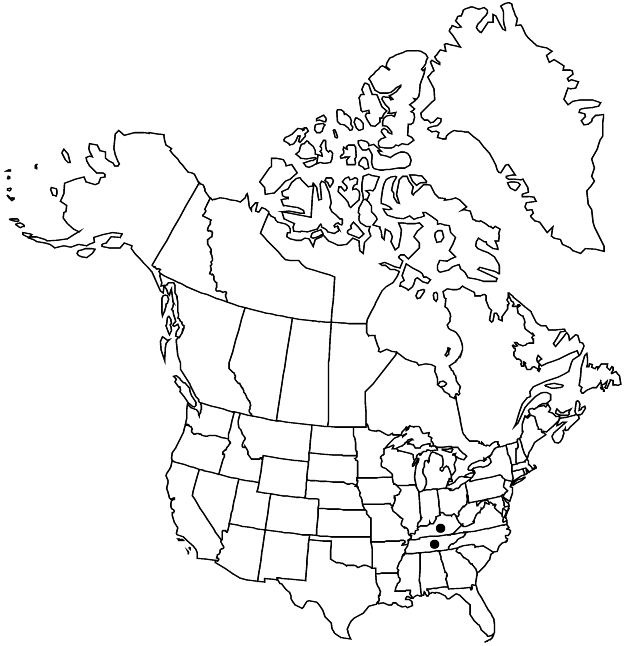Difference between revisions of "Stellaria fontinalis"
Proc. Amer. Acad. Arts 29: 286. 1894.
FNA>Volume Importer |
FNA>Volume Importer |
||
| Line 15: | Line 15: | ||
|name=Alsine fontinalis | |name=Alsine fontinalis | ||
|authority=(Short & R. Peter) Britton | |authority=(Short & R. Peter) Britton | ||
| − | }}{{Treatment/ID/Synonym | + | }} {{Treatment/ID/Synonym |
|name=Arenaria fontinalis | |name=Arenaria fontinalis | ||
|authority=(Short & R. Peter) Shinners | |authority=(Short & R. Peter) Shinners | ||
| − | }}{{Treatment/ID/Synonym | + | }} {{Treatment/ID/Synonym |
|name=Spergula fontinalis | |name=Spergula fontinalis | ||
|authority=(Short & R. Peter) Dietrich | |authority=(Short & R. Peter) Dietrich | ||
| Line 36: | Line 36: | ||
|elevation=400-500 m | |elevation=400-500 m | ||
|distribution=Ky.;Tenn. | |distribution=Ky.;Tenn. | ||
| − | |discussion=<p>Stellaria fontinalis is a very rare and poorly known species of uncertain affinity. Its characters are closer to Sagina and Minuartia than Stellaria, in particular the absence of petals, the 4(–5)-merous flowers, and the distinctive sculpturing of the seeds.</p> | + | |discussion=<p><i>Stellaria fontinalis</i> is a very rare and poorly known species of uncertain affinity. Its characters are closer to <i>Sagina</i> and <i>Minuartia</i> than <i>Stellaria</i>, in particular the absence of petals, the 4(–5)-merous flowers, and the distinctive sculpturing of the seeds.</p> |
|tables= | |tables= | ||
|references= | |references= | ||
| Line 60: | Line 60: | ||
|publication year=1894 | |publication year=1894 | ||
|special status= | |special status= | ||
| − | |source xml=https://jpend@bitbucket.org/aafc-mbb/fna-data-curation.git/src/ | + | |source xml=https://jpend@bitbucket.org/aafc-mbb/fna-data-curation.git/src/8f726806613d60c220dc4493de13607dd3150896/coarse_grained_fna_xml/V5/V5_217.xml |
|subfamily=Caryophyllaceae subfam. Alsinoideae | |subfamily=Caryophyllaceae subfam. Alsinoideae | ||
|genus=Stellaria | |genus=Stellaria | ||
Revision as of 17:37, 18 September 2019
Plants annual; taproot slender. Stems straggling to ascending, branched, square, 10–25 cm, glabrous. Leaves sessile; blade with obscure midrib, narrowly oblanceolate to linear-spatulate, 1–3 cm × 0.8–4 mm, somewhat fleshy, base cuneate, margins entire, apex ± acute, glabrous. Inflorescences with flowers solitary in distal leaf axils; bracts absent. Pedicels ascending or erect, 10–40 mm, glabrous. Flowers 2.5–4 mm diam.; sepals 4(–5), 3-veined, ovate-lanceolate, 2.5–3 mm, margins narrow, scarious, apex ± acute, glabrous; petals absent; stamens 4(–5), shorter than sepals; styles 3 or 4, ascending, ca. 0.5 mm. Capsules green or straw colored, ovoid, ca. 3 mm, ± equaling sepals, apex obtuse, opening to base into 3 or 4 valves; carpophore absent. Seeds dark red-brown, orbiculate-reniform, 0.6 × 0.8 mm, shiny, tuberculate; tubercles prominent, stalked and knoblike.
Phenology: Flowering spring.
Habitat: Seasonally wet, rocky openings in wooded glades, on wet cliffs
Elevation: 400-500 m
Discussion
Stellaria fontinalis is a very rare and poorly known species of uncertain affinity. Its characters are closer to Sagina and Minuartia than Stellaria, in particular the absence of petals, the 4(–5)-merous flowers, and the distinctive sculpturing of the seeds.
Selected References
None.
